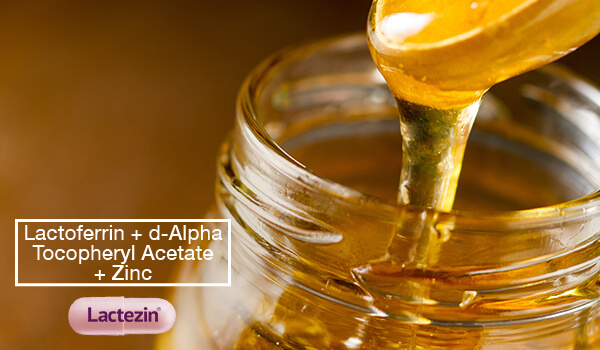Lactoferrin 101: Myths, Dosage & Health Benefits

A nutrient found in some of today’s supplements, lactoferrin packs a number of health benefits. Some true, others sensationalized. In this read, separate facts from myths as we cover the basics such as the recommended dosage for lactoferrin, and the proven benefits.
An Intro to Lactoferrin
A single-chain protein found naturally in milk from humans and cows, lactoferrin is known for its iron-binding property which plays a role in the transport of iron into and between various internal organisms such as cells and bile. It is also present in several other fluids in the body such as saliva, tears and mucus.
Aside from binding with and transporting iron, lactoferrin also helps fight infections with its antioxidant and anti-inflammatory benefits.
Separating Facts from Myths
As with most topics, the Internet can be a good source of information if you want to know more about lactoferrin. However, information from the world wide web can always be overwhelming. Oftentimes, facts and details can even be contradicting. Steer clear of misleading write ups about the protein. Check this short list of the usual myths and the facts behind each one.
Myth 1: Lactoferrin only exists in cow’s milk
As previously mentioned, lactoferrin can be found in cow milk and human milk. Aside from the mammary gland, the protein containing 703 amino acids is also synthesized in the lacrimal, bronchial and salivary glands. This is why you’ll also find lactoferrin in fluids in the eyes, nose, respiratory tract, intestine and others.
Myth 2: Lactoferrin can only be found in colostrum
Colostrum is the first secretion of milk from the mammary glands after giving birth. While it’s true that lactoferrin is abundant in colostrum, production or synthesis of the protein continues after colostrum is produced.
Myth 3: One can get Mad Cow Disease from Lactoferrin
Because the nutrient may be sourced from cows, there’s a circulating fear that mad cow disease is a possibility when consuming lactoferrin. Mad cow disease is a fatal disease that slowly deteriorates the brain and spinal cord in cattle. There is no evidence that people can get mad cow disease from eating cattle meat or from consuming milk and milk products.
Myth 4: Lactoferrin is another name for Apolactoferrin
Apolactoferrin is another common ingredient in supplements. While it may seem so, apolactoferrin is not the same as lactoferrin. Rather, it’s a component of the protein.
Myth 5: Lactoferrin helps cures cancer
Although there have been studies that demonstrate Lactoferrin’s potential in preventing and treating tumors, results have been inconsistent. More research and studies are needed to prove Lactoferrin’s effectiveness in reversing or treating cancer.
Myth 6: Lactoferrin dosage: the more, the better
Present in many supplements, lactoferrin can be taken for a number of reasons. And dosage will depend on your purpose. As a general reminder, it is recommended that you consult your doctor before taking any medicine, including vitamins. A health professional will be in the best position to advise on what is the most suitable lactoferrin dosage, based on your age, health status and nutritional needs.
More on Lactoferrin Dosage
While it’s a naturally occurring protein in the body, lactoferrin in large doses can result in diarrhea, skin rashes and fatigue, among other unpleasant effects. The acceptable intake level (AIL) of Lactoferrin sourced from dietary supplements ranges from 10 to 1200mg per day.
The Proven Benefit of Lactoferrin
To further add clarity into what lactoferrin can do for you, check out this runthrough on the proven health benefits of Lactoferrin.
- Lactoferrin may Inhibit Hepatitis C
Numerous studies show that lactoferrin hinders the progress of hepatitis C. A 2013 study from Hepatology Research found that lactoferrin helps increase the levels of a key immune-system protein that fights off the hepatitis C virus.
- Lactoferrin helps prevent Osteoporosis
Research and laboratory tests found that lactoferrin stimulates the growth of bone-forming cells called osteoblasts, and significantly reduces bone resorption in postmenopausal women.
- Lactoferrin supports the body’s immune system
Thanks to its antiviral properties, lactoferrin helps protect the body from pathogenic microorganisms such as bacterial, viral and fungal infections. In a 2014 report published in Journal of Infection and Chemotherapy, lactoferrin is observed to inhibit the attachment of viruses to cells.
- Lactoferrin aids in the prevention of ulcer
A 2014 report in the World Journal of Gastroenterology writes that researchers analyzed previous clinical trials on the effect of fermented milk and its components including lactoferrin against an infection known to cause ulcers. Results reveal that lactoferrin may help treat the infection, and reduce infection rates.
- Lactoferrin helps minimize acne
The nutrient’s antibacterial, antioxidant and anti-inflammatory properties are a triple threat for acne. Acne-causing acne and inflammation are kept at bay while skin cell renewal is kept healthy and optimized.
Experience lactoferrin’s power over pimples and acne, along with the benefits of vitamin E and zinc in regular intake of Lactoferrin + d-Alpha Tocopheryl Acetate + Zinc (Lactezin).
Get your acne questions answered with expert pimple care tips and advice, only from Lactezin.
SOURCES:
https://www.verywellhealth.com/the-benefits-of-lactoferrin-89471
https://www.healthlinkbc.ca/health-topics/tu6533
https://www.webmd.com/vitamins/ai/ingredientmono-49/lactoferrin
https://www.dairynutrition.ca/facts-fallacies/health-concerns/acne-nutrition-and-milk-products
https://www.sciencedirect.com/topics/food-science/lactoferrin


